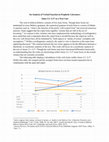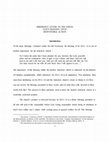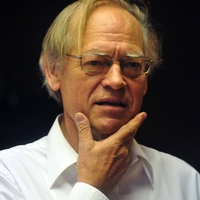Drafts by Ron Lindo
This is a short word study on the collocational sense of καθεξης as compared to ἑξῆς.

The verb in biblical Hebrew consists of five main forms. Though these forms are mentioned in ever... more The verb in biblical Hebrew consists of five main forms. Though these forms are mentioned in every Hebrew grammar, the syntactical purpose of each form is a source of debate. A question such as, " what is the function of the prefix verb (yiqtol) form " has received numerous answers. Some suggest that the yiqtol form signifies " actions that are still in the act of becoming. " In contrast to this, scholars who have emphasized the methodology of textlinguistics have noted that such a statement about the yiqtol form is invalid because the yiqtol (as well as the over verb forms) have all be translated by " both aspects or 'modes of action' (complete and incomplete). " Within a textlinguistics analysis, the yiqtol is view to function as the main form signifying discourse. The contrast between the two views appears to be the difference between a diachronic or synchronic analysis of the text. This work will focus on a synchronic analysis of the text of Amos 3:1–5:17. Though the verb forms may have functioned differently historically, an understanding how the verbs are functioning within Amos 3:1–5:17 must focus on the textual witness that are currently accessible.
The Septuagint (LXX) and Masoretic Text (MT) of the book of Jeremiah demonstrate that Jeremiah’s ... more The Septuagint (LXX) and Masoretic Text (MT) of the book of Jeremiah demonstrate that Jeremiah’s textual history is one of extremely complexity. This fact was only exaggerated by the discovery of the Dead Sea Scrolls. In some ways, the discovery of the Dead Sea Scrolls verified the LXX as primary, in other ways the MT, and still in other ways the scrolls hinted at a possible third version of the book. This has led many to question the current definition of the term “autograph.” Thus, this article will seek to overview the history of research concerning the LXX and MT of Jeremiah in hopes of finding a way forward through the collected minds of the past. This article will not seek to imply any definitive solutions to this problem, but only suggestions that will be inferred from the work of those who came before.
This draft explores the syntactical cohesion of the first chapter of Jeremiah.
Conference Presentations by Ron Lindo

Modern biblical scholars have often explored the theological concept of dual citizenship. Often t... more Modern biblical scholars have often explored the theological concept of dual citizenship. Often the focus of this conversation is bent toward the New Testament. However, this concept is also robustly discussed in various Old Testament texts. In this paper, I will explore how the description of being a "Judahian" י( ְהּודִ )י in Esther provides various insights into how Christians should engage with culture while living as dual citizens. This concept is engrained into Esther's very structure, which shares an isomorphic relationship with 1 Peter. While an explicit citation from Esther is lacking, within 1 Peter, there are several allusions, thematic connections, and structural references to the Esther story. When Peter sought to demonstrate how Christians should live in the diaspora, he found a theological foundation in the actions of the "Judahians" who chose to remain in Persia. Thus, the model presented to us within the text of Esther should influence how we seek to live in secular societies, just as it did for the apostle Peter.

Of the many blessings contained within the Old Testament, the blessing of Jer 29:11–14 is one of ... more Of the many blessings contained within the Old Testament, the blessing of Jer 29:11–14 is one of modern importance for the American church.
For I know the plans that I have planned for you, declares the Lord, peaceful plans and not contentious ones; to give to you a future and hope. And you will pray to me and I will hear you. And you will seek me and you will find me. For you must search for me with all your heart, then I will appear to you…
The importance of this blessing within the modern American church is witnessed by the plethora of Christian paraphernalia, which references Jer 29:11–14 as its inspiration. Two questions, then, stem from meditating on Jer 29:11–14 and the American church’s desire to obtain it: (1) How can one receive the blessing presented in these words, and (2) what does a life devoted to these words look like? The answers to these questions seem to place the modern American church in a somewhat awkward position.
This paper was a finalist in the Intersect Project Ph.D. Student Challenge Symposium. The symposium facilitated broader discussion in the church and academy about the intersection of faith, work, and economics.
Book Reviews by Ron Lindo
This is a book review of Such a Mind as This by Richard Smith. I completed this review for the So... more This is a book review of Such a Mind as This by Richard Smith. I completed this review for the Society of Christian Scholars. You can find more information about the society here: https://scshub.net/
This is a review of The Truth about Tolerance by Stetson and Conti.
This is a review of Evangelicals in the Public Square by J. Budziszewski.
This is a review of Jungho Kim's doctoral dissertation at Bob Jones University.
This work provides a short overview and critique of Herman Gunkel's seminal work.
This is a book review of Reconstructing Old Testament Theology by Leo Perdue.
This is a review of the book Evangelical Theological Method edited by Stanley E. Porter and Steve... more This is a review of the book Evangelical Theological Method edited by Stanley E. Porter and Steven M. Studebaker.
This is a review of The Pentateuch written by Terence Fretheim.
The review provides a summary and short critique of Amihai Mazar's well-known Archaeology of the ... more The review provides a summary and short critique of Amihai Mazar's well-known Archaeology of the Bible.
This is a review of Reading Moses, Seeing Jesus by Seth Postell, Eitan Bar, and Erez Soref.
This is a detailed analysis of the book, The Faces of Old Testament Studies.
This article is a summary of the material contained with Old Testament Theology: Flowering and Fu... more This article is a summary of the material contained with Old Testament Theology: Flowering and Future.
Hasel's work has been revised four times because of its usefulness for anyone interested in the f... more Hasel's work has been revised four times because of its usefulness for anyone interested in the field of Old Testament theology and biblical theology. The value of this work is found within its two main contributions to the study of OT theology. First, Hasel's work has constantly been given an updated bibliography to provide his readers with nearly nine hundred and fifty entries so that they would have a " working tool for those who wish to pursue any subject in greater detail " (x). Second, though there are other overviews of the study of OT theology, only this work deals with some of the " major unresolved problems " during the time of Hasel. Thus, modern scholars have the opportunity gain from Hasel's insights and attempt to resolve these problems.











Uploads
Drafts by Ron Lindo
Conference Presentations by Ron Lindo
For I know the plans that I have planned for you, declares the Lord, peaceful plans and not contentious ones; to give to you a future and hope. And you will pray to me and I will hear you. And you will seek me and you will find me. For you must search for me with all your heart, then I will appear to you…
The importance of this blessing within the modern American church is witnessed by the plethora of Christian paraphernalia, which references Jer 29:11–14 as its inspiration. Two questions, then, stem from meditating on Jer 29:11–14 and the American church’s desire to obtain it: (1) How can one receive the blessing presented in these words, and (2) what does a life devoted to these words look like? The answers to these questions seem to place the modern American church in a somewhat awkward position.
This paper was a finalist in the Intersect Project Ph.D. Student Challenge Symposium. The symposium facilitated broader discussion in the church and academy about the intersection of faith, work, and economics.
Book Reviews by Ron Lindo
For I know the plans that I have planned for you, declares the Lord, peaceful plans and not contentious ones; to give to you a future and hope. And you will pray to me and I will hear you. And you will seek me and you will find me. For you must search for me with all your heart, then I will appear to you…
The importance of this blessing within the modern American church is witnessed by the plethora of Christian paraphernalia, which references Jer 29:11–14 as its inspiration. Two questions, then, stem from meditating on Jer 29:11–14 and the American church’s desire to obtain it: (1) How can one receive the blessing presented in these words, and (2) what does a life devoted to these words look like? The answers to these questions seem to place the modern American church in a somewhat awkward position.
This paper was a finalist in the Intersect Project Ph.D. Student Challenge Symposium. The symposium facilitated broader discussion in the church and academy about the intersection of faith, work, and economics.
study. The title of this new method is Editorial Design. One who utilizes this method will provide an integrated reading of a text according to the grammatical, scribal, cross-associational (i.e., intertextual), and canonical devices embedded in its finalized form. In other words, these four contours create the boundaries by which the interpreter asks questions related to the textual
evidence.